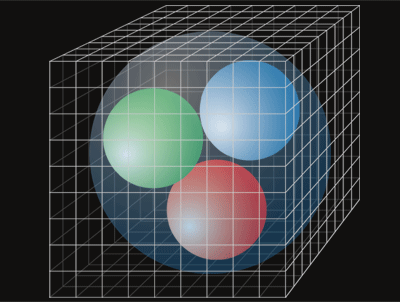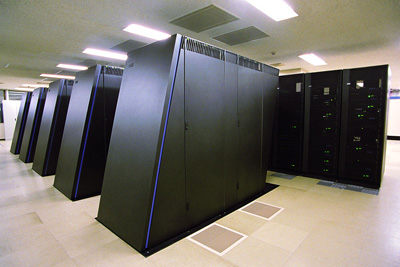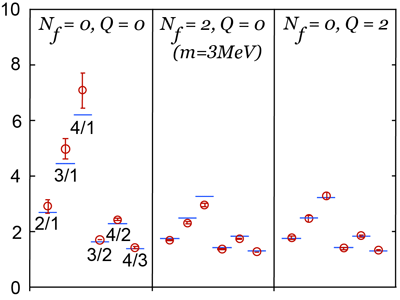A research group led by Shoji Hashimoto, Ph. D., an associate professor at KEK, succeeded for the first time to reproduce the phenomena of spontaneous symmetry breaking in Quantum Chromo-Dynamics (QCD) using numerical simulations.
Quarks, the elementary particles forming nucleon, carry only two per cent of the mass of the nucleon, leaving the remaining 98% due to the so-called spontaneous chiral symmetry breaking. This widely accepted idea among researchers has not yet been proven theoretically starting from QCD, the fundamental theory of quarks. Solving QCD is an extremely difficult problem.
Chiral symmetry is a symmetry distinguishing right-handed spinning quarks from their left-handed cousins. This symmetry is exact when the quarks can fly at the speed of light which is possible if they are massless. In 1961 Yoichiro Nambu and his collaborator proposed the idea of spontaneous chiral symmetry breaking, inspired by the BCS (Bardeen-Cooper-Schrieffer) mechanism of superconductivity. In the BCS theory, spin-up and spin-down electrons form a pair and condense in the material. Their motion as a pair is smooth so that electrical resistance vanishes, while separating an electron from its partner requires a lot of energy. In QCD the pair is produced by a quark and an anti-quark, making the vacuum full of the condensed quark-antiquark pairs. As a result, the chiral symmetry is broken and individual quarks acquire masses. All of these happen secretly in the vacuum due to the strong force of QCD.
The research group used a numerical simulation of QCD defined on a lattice to reproduce the spontaneous chiral symmetry breaking. In this work the group employed a special kind of lattice formulation of quarks --- the overlap fermion proposed by Herbert Neuberger in 1998 --- in order to realize an exact chiral symmetry on the lattice, which has never been possible using other fermion formulations. The overlap fermion is theoretically an ideal formulation, but numerically a nightmare, because it requires more than 100 times more computer power than other fermion formulations. This work has been made possible by a brand-new supercomputer and steady improvements of numerical algorithms.
The group carried out a QCD simulation including extraordinary light quarks to calculate eigenvalues of quarks. The simulation results reproduce this theoretical prediction nicely (Fig. 3). It implies that, due to the chiral symmetry breaking, light pions appear and behave just as expected. This result provides a firm ground for further understanding of nucleon and nucleus based on the fundamental theory, i.e. QCD.
The numerical simulations have been performed on the supercomputer "IBM System BlueGene Solution" installed at KEK in March 2006.
This work will soon be published on the "Physical Review Letters" (online version).
| |
[ Related Web Site ] IPNS Theoretical Research Groups |
| |
[ Contacts ] |
|
| |
Shoji Hashimoto
Associate Professor
Institute of Particle and Nuclear Physics, KEK
+81-29-864-5397 |
Youhei Morita
Head
Public Relations Office, KEK
+81-29-879-6047 |
 |
| Figure 1 : QCD on the lattice |
 |
| Figure 2 : Supercomputer "IBM System BlueGene Solution" provides 57 Tera Flops peak performance. The machine is under operation since March 2006. |
 |
| Figure 3 : Eigenvalues of quarks: QCD in a small box has discrete eigenvalues of quarks. This plot shows their ratios. "2/1", "3/1" etc. denote the ratio of second-to-first or third-to-first eigenvalues. The middle panel shows the recent result including dynamical light quarks. |
|



